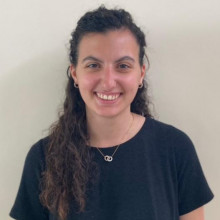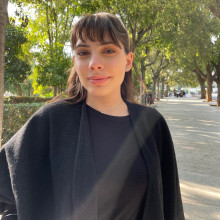

Vasiliki Koutrouli is currently a Ph.D. student at the Department of Physics of the University of Crete and a member of the Quantum Magnetometry at the Institute of Electronic Structure and Laser, Foundation for Research and Technology – Hellas. She received her Bachelor's Degree and her Master's Degree from the Department of Physics, Aristotle University of Thessaloniki, in 2020 and 2022 respectively.
Education
- 2020, Bachelor of Science, Aristotle University of Thessaloniki, Department of Physics
- 2022, Master of Science, Aristotle University of Thessaloniki, Department of Physics
Interests
- Quantum optics
- Atomic-optical Physics
- Strain sensors for bioelectronic applications


Ms Aikaterini Kadianaki is currently a postgraduate student in the division of Advanced materials / Physical chemistry at the Department of Chemistry of the University of Crete and member of the Hybrid Nanostructures Group of the Institute of Electronic Structure and Laser, Foundation for Research and Technology – Hellas. She received her Bachelor’s Degree from the Department of Chemistry, Aristotle University of Thessaloniki, in 2021.
Education
- 2021, Bachelor of Science, Aristotle University of Thessaloniki, Department of Chemistry
Interests
- Organic-inorganic nanohybrid materials
- Polymer nanocomposites with clays

Gaitanou Dimitra is currently a postgraduate student at the Department of Materials Science and Technology of the University of Crete and a member of the Hybrid Nanostructures Group of the Institute of Electronic Structure and Laser, Foundation for Research and Technology – Hellas.
Education
- 2020, Bachelor of Science, University of Crete, Department of Materials Science and Technology
Interests
- Porous polymers
- CO2 capture and conversion
- Heterogeneous Catalysis
- Polymers for environmental applications

Georgios Dimitrios Fergadis is currently a postgraduate student in the Biomedical Engineering program of the Medical School of the University of Crete and a member of the Hybrid Nanostructures Group of the Institute of Electronic Structure and Laser, Foundation for Research and Technology. He received his Bachelor’s Degree from the Department of Materials Science and Technology, University of Crete, in 2020.
Education
- 2020, Bachelor of Science, University of Crete, Department of Materials Science and Technology
Interests
- Polymer synthesis and characterization
- Polymers for biomedical applications
- Self-assembly of polymers
- Drug delivery systems

Kalliope Plexousaki is currently an undergraduate student at the Department of Chemistry of the University of Crete and an undergraduate trainee at the Hybrid Nanostructures Laboratory of the Institute of Electronic Structure and Laser, Foundation for Research and Technology – Hellas. She is expected to receive her Bachelor’s Degree, from the Department of Chemistry, University of Crete, in September 2022.
Interests
- Organic-Inorganic Nanohybrid Materials
Funding


Varvara Platania is currently a PhD candidate at the Laboratory of Biomaterials for Tissue Engineering at the Department of Materials Science and Technology of the University of Crete and a member of the Hybrid Nanostructures Group of the Institute of Electronic Structure and Laser, Foundation for Research and Technology – Hellas.
She received her Bachelor’s Degree from the Department of Biological Applications and Technology, University of Ioannina in 2016.
Education
- 2019, Master of Science, National Kapodistrian University of Athens, School of Medicine
- 2016, Bachelor of Science, University of Ioannina, Department of Biological Applications and Technology
Awards/Prizes/Distinctions
- Biomaterials for bone and vascular tissue engineering and growth factor delivery
- Cell-biomaterial interactions including cell viability, morphology, differentiation - Bioprinting

Danai Papadogianni is currently (from Dec. 2020-Jan. 2022) a PhD candidate at the Laboratory of Biomaterials for Tissue Engineering at the Department of Materials Science and Technology of the University of Crete and a member of the Hybrid Nanostructures Group of the Institute of Electronic Structure and Laser, Foundation for Research and Technology – Hellas.
She received her Bachelor’s Degree from the Department of Materials Science and Technology, University of Crete in 2018.
Education
- 2020, Master of Science, University of Crete, School of Medicine
- 2018, Bachelor of Science, University of Crete, Department of Materials Science and Technology
Awards/Prizes/Distinctions
- Biomaterials for bone and cartilage tissue engineering
- Cell-biomaterial interactions including cell viability, morphology, differentiation - Bioprinting



